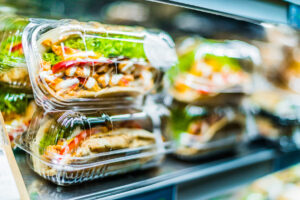
In spite of the productivity gains remote workers had during the pandemic, more and more companies are transitioning back to the office—at least part time. Last fall, commercial building occupancy rates in major cities ranged from 40-60%. So, while there are fewer people downtown than in 2019, a decent number of workers are returning.
The return to the office means the return of the work lunch. Rather than snacking on whatever they have in the refrigerator, office workers now have a choice: pack a lunch ahead of time or buy something near the office.
This presents a great opportunity for the humble sandwich. Sandwiches are the platonic ideal of lunch food in the United States. They’re transportable, highly customizable, and quick to prepare. After a lifetime of peanut butter and jelly or ham and cheese during their school years, many workers consider sandwiches synonymous with lunch. Downtown foodservice operators should consider sandwiches alongside other takeaway offerings to maximize office worker sales.
Here are a few things manufacturers should consider when supporting foodservice operators during the sandwich-powered lunch rush:
Develop Opportunities for Add-Ons
When people buy a sandwich, they almost never buy just a sandwich. In Foodservice IP’s recent study, we found that only 19% of consumers purchased a sandwich only. The most common ticket was “a sandwich, a side, and a beverage” (40%), followed by “a sandwich and a beverage” (30%), and “a sandwich and a side” (11%).
Sandwiches are a great opportunity to increase check values. In order to do that, operators need to deliver on quality ingredients, maintain freshness, and offer appropriate sides and beverages at a reasonable price.
Emphasize Catering for Corporate Clients
Returning to the office is expensive for workers. Owl Labs estimates that hybrid workers spend $51 per day on their back-to-work routine, including $29 per day on breakfast, lunch, and coffee. Many workers are negotiating benefits to defray these expenses. While this includes commuter and childcare benefits, some are also demanding that their bosses buy them lunch.
While that may seem surprising, there could be a business case for giving employees free lunch. Taking a lunch break at work can improve employee productivity and well-being; taking lunch with colleagues can enhance team performance. As a result, many employers have started offering free food to encourage staff to return to the office.
This trend presents an opportunity for manufacturers and foodservice operators with sandwich offerings. Sandwiches are perfect for office catering. They are transportable and pre-proportioned, easily accommodate various dietary preferences, and may not require some typical catering costs (e.g., plates and utensils). If sandwiches offer higher than average check prices, sandwich catering can capture higher than average check prices at scale.
The Bottom Line
This year is a time of flux. Lunch will play a big role in how companies and workers re-evaluate their relationship to office life. Manufacturers and foodservice operators can capitalize on these changes by offering sandwiches and add-ons for individual consumers, and sandwich catering for corporate buyers.
This article shares a few insights from Foodservice IP’s recent sandwich study. Contact us to learn more. Foodservice IP is a professional services firm aimed at delivering ideas for managers to guide informed business decisions. To learn more about FSIP’s Management Consulting Practice, click here.
Like the content? Sign up to receive our communications.
Recent Comments